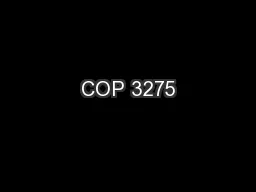

Computer Programming Using C Instructor Diego RiveraGutierrez djrgciseufledu httpciseufledudjrg httpsufcprog2015wordpresscom COP 3275 Computer Programming Using C ID: 151349
Download Presentation The PPT/PDF document "COP 3275" is the property of its rightful owner. Permission is granted to download and print the materials on this web site for personal, non-commercial use only, and to display it on your personal computer provided you do not modify the materials and that you retain all copyright notices contained in the materials. By downloading content from our website, you accept the terms of this agreement.
Slide1
COP 3275 Computer Programming Using C
Instructor: Diego Rivera-Gutierrez
djrg@cise.ufl.edu
http://cise.ufl.edu/~djrg
/
https://ufcprog2015.wordpress.com
/
Slide2
COP 3275 Computer Programming Using C
Instructor: Diego
Rivera
-Gutierrez
djrg@cise.ufl.edu
http://cise.ufl.edu/~djrg
/
https://ufcprog2015.wordpress.com
/
Slide3
COP 3275
My office hours: Monday and Wednesday 10am-11am (before class) E520 CSE Building.
TA: Rahul
Prabhu
email:
rprabhu@cise.ufl.edu
Office hours: TBA (starting next week)
Recommended Textbook:
Programming in C,
Stephen G.
Kochan
4
th
EditionSlide4
Grading
5% Class participation
45% Homework projects
First homework is due next week! (May 18
th
)
50% Quizzes
Mostly every Friday starting on the second Friday (May 22nd)If needed grades will be curved at the end of the semester
A
A-
B+
B
B-
C+
C
C-
D+
D
D-
F
[100-96]
(96-92]
(92-88]
(88-84]
(84-80]
(80-76]
(76-72]
(72-68]
(68-64]
(64-60]
(60-56]
(56-0]Slide5
Some policies
Late assignments:
-10% per day late
No submissions will be accepted after 3 days
Honesty policy:
UF students are bound by The Honor Pledge which
states.
To reduce distractionsTurn off all cell phone ringersNo open laptops (unless we are doing a class exercise)Do not read the newspaperSlide6
Any Questions?Slide7
So, what is this class about?
Computers
Programming
Programming Languages
The C Programming Language
Today I’ll give you a brief introduction to these concepts and set the expectations for what you will be able to accomplish after taking this class.Slide8
What is a computer?
“Claude Shannon, artificial intelligence pioneer and founder of information theory, met his wife, Mary Elizabeth, at work. This was Bell Labs in Murray Hill, New Jersey, the early 1940s. He was an engineer, working on wartime cryptography and signal transmission.
She was a
computer
.”
Brian Christian – The Most Human
HumanSlide9
What is a computer
A “general purpose” electronic device
1943
1975
~1990
2014Slide10
General purpose?
A computer does what we tell it to do.
How do we tell a computer what we want it to do?
Through programs!
What is a program?
Sequence of instructions that a computer can understand
An
algorithm, on the other hand, is a general strategy used to solve a specific problemSlide11
Binary languages
Turns out computers are kind of dumb
They only understand two types of voltages (Binary language):
High (True, 1)
Low (False, 0)
They can perform very basic operations: addition, subtraction, multiplication, division, comparisons,
etc
So a program a computer could understand may look like:10010101011100011100101110101010 Slide12
Instruction sets
An instruction set is the convention of what those 1s and 0s actually mean to an specific computer.
10010101011100011100101110101010
We may say that:
an instruction is 32 bits (or numbers)
100101 at the beginning means “
add
”0101110001110 represents a number0101110101010 represents another numberDifferent computers understand different instructions sets (x86, ARMv8, MIPS, etc)Slide13
1943Slide14
Programming languages and compilers
Programming languages are formally constructed
languages
designed to communicate instructions to a computer.
Language!
They look closer to English, and much easier to learn than binary. They have
Defined
lexiconDefined syntaxDefined semanticsSlide15
Programming languages and compilers
A compiler is a program that interprets a programming language and transforms it to a specific machine language.
Writing a program is like writing a short story, essay, book, or novel.Slide16
Why C?
Extremely powerful
language
C is the base language for most modern programming languages
C++, Java, C#, PHP,
Matlab
, etc.
And because you chose to take this particular class!Slide17
In this class
You will learn enough C to understand most “books” and “novels” written in C
You will learn enough to write your own “short stories”
We will be using the
gcc
compiler.
Please go to
http://register.cise.ufl.edu/ and register for a CISE Departmental Account.Download Putty!Next class:We will discuss the development environmentWe will go over our very first simple program
That program might or might not look extremely similar to your homework assignment.